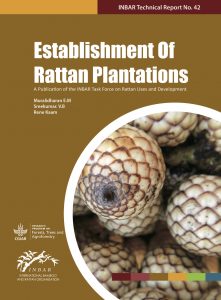This article was originally published on the INBAR website.
A new technical report provides guidelines on how to establish and maintain a sustainable rattan plantation.
Rattans are among the most important non-wood forest products of tropical forests. They provide a substantial source of income for many people in rural communities, and are a high-quality material for use in furniture and handicrafts. Because rattans grow up trees, they are inextricably linked with forest protection; sustainably managed rattan can protect forests while also improving livelihoods.

However, unregulated extraction of rattan from natural forests has led to a depletion of stocks, and a degraded quality of material. Better practices are needed for establishing and managing rattan plantations, to enhance rattan resources and ensure their sustainability. A new report, written by members of INBAR’s Rattan Task Force, summarises the most useful research in this field. Establishment of Rattan Plantations draws on experiences and research from a number of countries to summarise how to choose and propagate species, how to manage the plantation, and how to conduct a cost-benefit analysis.
Currently, rattan cultivation is only practiced to a limited extent in countries like Indonesia, Malaysia and the Philippines. In the foreword, the report authors E.M. Muralidharan and Rene Kaam say: “Rattans contribute substantially to the livelihood and economic status of local communities in many countries, [so] it is important to establish rattan plantations which ensure sustainable availability and sufficient economic returns.”
The authors hope that this report will “kindle interest in commercial rattan plantations of different types”, as well as encouraging further research into the factors that influence optimum rattan growth and quality.
This research was carried out by INBAR as part of the CGIAR Research Program on Forests, Trees and Agroforestry (FTA). FTA is the world’s largest research for development program to enhance the role of forests, trees and agroforestry in sustainable development and food security and to address climate change. INBAR is a partner of FTA.
The report can be downloaded here. It can be cited as: Muralidharan, E.M., Sreekumar, V.B., Kaam, R. (2020) Establishment of Rattan Plantations. INBAR Technical Report No. 42. INBAR: Beijing, China.
INBAR is one of the FTA managing partners. FTA is the world’s largest research for development program to enhance the role of forests, trees and agroforestry in sustainable development and food security and to address climate change. CIFOR leads FTA in partnership with Bioversity International, CATIE, CIRAD, INBAR, ICRAF and TBI. FTA’s work is supported by the CGIAR Trust Fund.











